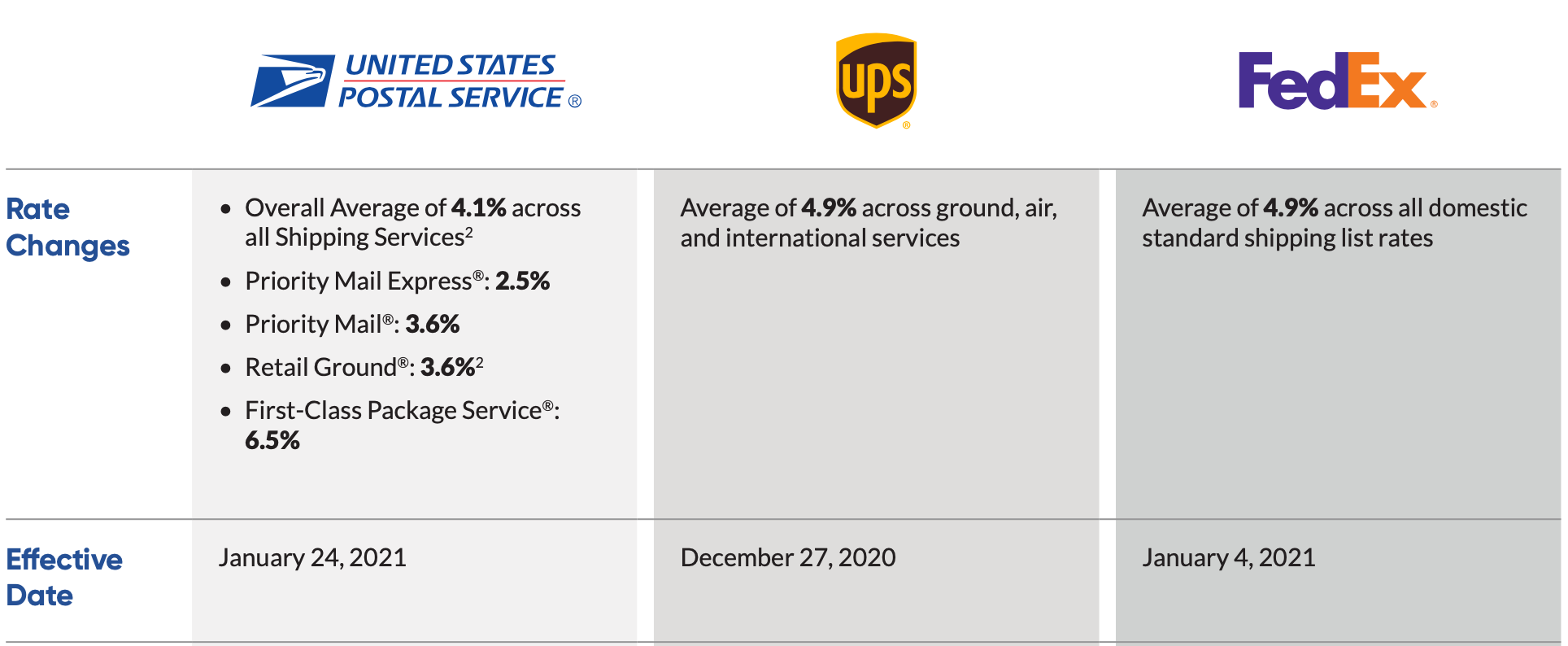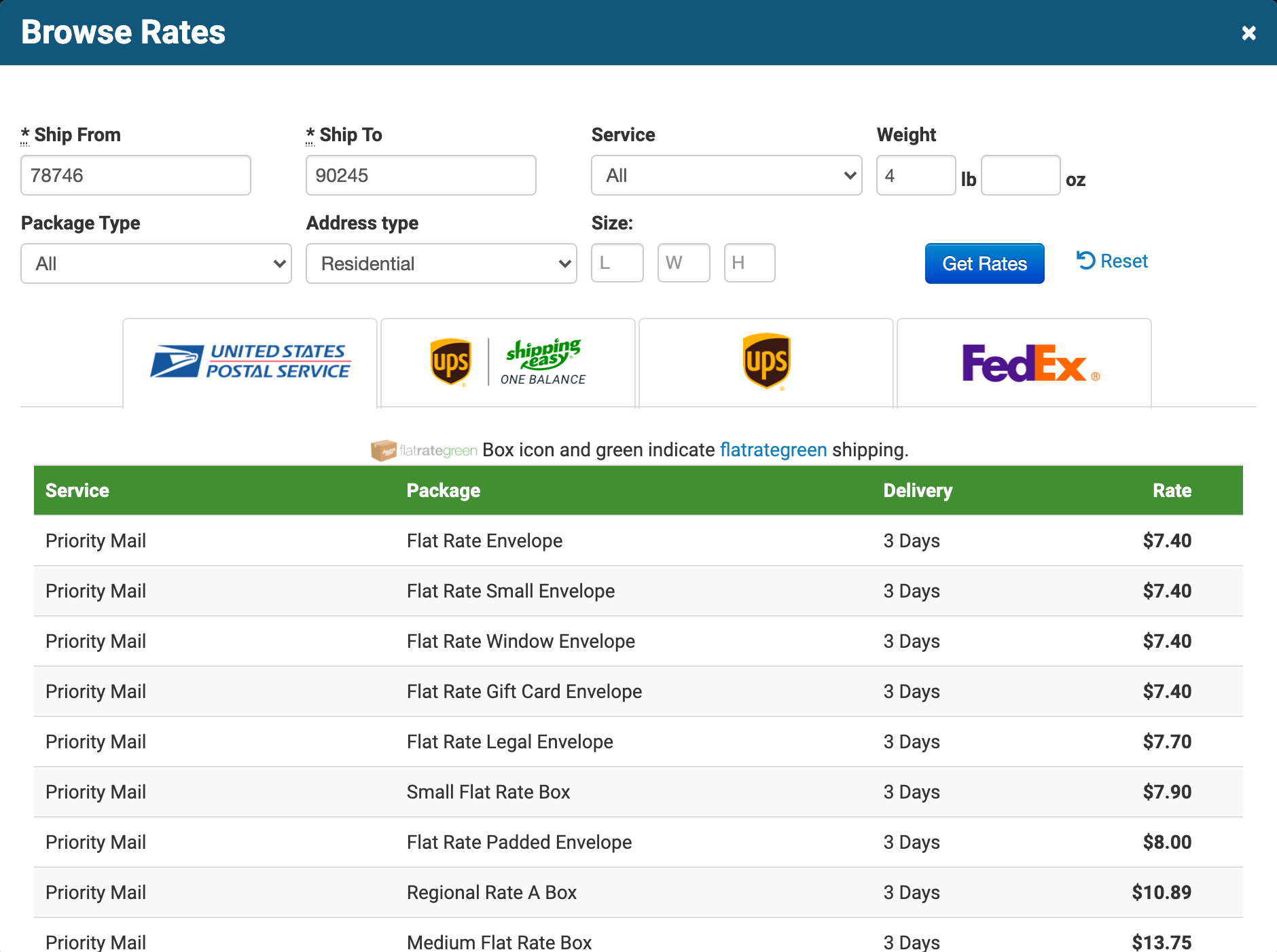The rates in this blog post are the 2020 USPS, UPS, and FedEx shipping rates. For the current 2023 USPS rates, visit our USPS 2023 Shipping Rate Changes: Flat Rate, Priority, First Class, w/Tables blog!
E-commerce merchants are always in search of lower shipping rates, particularly when offering free shipping to customers continues to cut into revenue. There are times when it is as simple as having access to the best rates or negotiating with a carrier. Other times, savings come from being a smarter shipper who evaluates all available options and makes an informed decision.
Ideally, you have the ability to do both. There’s a strategy to help you achieve lower shipping rates so you can offer your customers what they’ve come to expect, thanks to Amazon. The three tips below will help you on your way to offer free shipping without killing your bottom line.
Note: As of October 19, 2022, ShippingEasy now offers the lowest USPSⓇ shipping rates in the industry, and the rates reflected in this blog are prior to this change. For more information on these new rates, check out our blog!
Know the current shipping rates
The best place to begin is knowing what the lowest shipping rates actually are. Each year, USPS, FedEx, and UPS update their shipping rates to keep up with the times. 99% of the changes are increases, though occasionally some things decrease. With USPS, it’s merely a change in rates. With UPS and FedEx, there are increases in fees, surcharges, and changes to when and how those are applied.
The best way to understand all of these changes is to download our free E-commerce Seller’s Guide to the 2021 Shipping Rate Changes. In it, we break down what changed, by how much, and then compare those changes to help you make the smartest decisions.
We will give you a preview of some of that information in this article, as well.

In general, USPS increased rates around 4.1% as an average across services. UPS and FedEx both increased their costs by 4.9%, not including surcharges and fees, which we will touch on with an example.
E-commerce packages are often destined for residential addresses. This is where the standard services offered by FedEx and UPS become mildly problematic. While you may find decent rates based on a service/timeframe that works for you and your customers, inevitably you’ll be paying more once that invoice comes in.
As an example, a 2-pound package shipped using FedEx Ground Residential service would cost $9.42 for 0-150 miles. While that might be palatable for many merchants, a $4.35 residential fee will later be tacked on, an additional cost of about 46%. This also doesn’t include the constantly-fluctuating fuel surcharges.
Now, that being said, we’re not advocating for ignoring the benefit of using a multicarrier approach.
Multicarrier approach to lower shipping rates
With so many competing services, it only makes sense for merchants to use a multicarrier approach to find lower shipping rates. Every varying instance of your shipping can present different parameters where one carrier’s service may benefit you more than another. Parameters such as:
- Package dimensions
- Package weight
- Destination (distance, residential vs. business, international)
- Leniency when it comes to carrier-branded packaging vs. your own branding/plain boxes
- Product specs (can it fit in standard boxes or does it require specialty boxes)
- Delivery promise (guaranteed overnight vs 2-3 day window)
All of these parameters will vary widely by merchant, product, and circumstance. Having a platform that makes this easy and automated can be a key to success. This is exactly what ShippingEasy does. You can set rules to automate repetitive processes. Our system remembers shipping choices you made for replicated orders and automatically applies previously selected shipping methods.
You can compare carrier rates and services in a single screen after entering your package weight, dimensions, and destination to make sure you’re paying the lowest shipping rates possible. The image below shows what that screen looks like in our app.

Consider special situations and options
For quite a while, USPS reigned supreme in the area of offering flat rate options. These include USPS Priority Mail Flat Rate (different sized boxes with a single shipping cost up to 70 pounds) and Priority Mail Regional Rate (flat shipping rates based on the destination, skewed toward closer locations, up to 15 and 20 pounds, based on box A or B option respectively). FedEx introduced FedEx One Rate to compete a while back, and UPS introduced UPS Simple Rate in the fall of 2019. Neither of these services incorporates the fuel surcharges and residential fees that can make UPS and FedEx pricier options.
The chart below shows how much Priority Mail Flat Rate shipping with Commercial Rates (which can be accessed through a ShippingEasy account) compare to Retail Rates you’d pay through the post office on your own.
| USPS Priority Mail Flat Rate | 2020 Commercial Rates | 2021 Commercial Rates | Price Increase |
|---|---|---|---|
| Flat Rate Envelopes | $7.15 | $7.40 | $0.25 |
| Legal Flat Rate Envelope | $7.45 | $7.70 | $0.25 |
| Padded Flat Rate Envelope | $7.75 | $8.00 | $0.25 |
| Small Flat Rate Box | $7.65 | $7.90 | $0.25 |
| Medium Flat Rate Boxes | $13.20 | $13.75 | $0.55 |
| Large Flat Rate Boxes | $18.30 | $19.30 | $1.00 |
| APO/FPO/DPO Large Flat Rate Box | $16.80 | $17.80 | $1.00 |
Dimensional weight is another consideration when it comes to making sure you’re getting the lowest shipping rates. We have written a complete breakdown of dimensional weight here, but in a nutshell, your shipping costs are higher for packages whose dimensions are large, even if the package itself doesn’t weigh much. You pay for the amount of space a package takes up rather than its physical weight.
For USPS, dimensional weight doesn’t apply until a package exceeds 1 cubic foot, or 1,728 inches when multiplying L x W x H. FedEx and UPS apply dimensional weight to all sizes of packages. Dimensional weight makes it very important to enter your package dimensions into your shipping software so you and the platform are cognizant of when dimensional weight might apply.
Want to avoid paying dimensional weight prices? Try these strategies to save!
In 2019, USPS extended dimensional weight pricing to all of their major services, which caught some merchants off guard in June (USPS pushed the change back from the rest of their rate updates in January to give merchants and services like ShippingEasy time to make adjustments). Those who suffer most are merchants who ship large, light packages that can’t be split or condensed into smaller packaging, particularly flat rate options.
ShippingEasy’s award-winning Customer Success team is available via phone, email, and chat to help merchants like you make the smartest shipping decisions and save in the process.
Rob Zaleski
Latest posts by Rob Zaleski (see all)
- USPS 2023 Shipping Rate Changes - November 16, 2023
